Skelton, York
Skelton is a village and civil parish in the unitary authority of the City of York, in North Yorkshire, England. It is 4 miles (6.4 km) north northwest of the city of York, west of Haxby, and on the east bank of the River Ouse. Skelton was in the ancient royal Forest of Galtres and covers 977.3 hectares (3.77 square miles). Skelton was made a conservation area in 1973.[1]
| Skelton | |
|---|---|
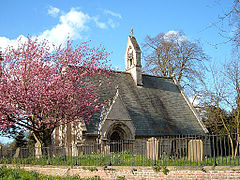 St Giles Church, Skelton | |
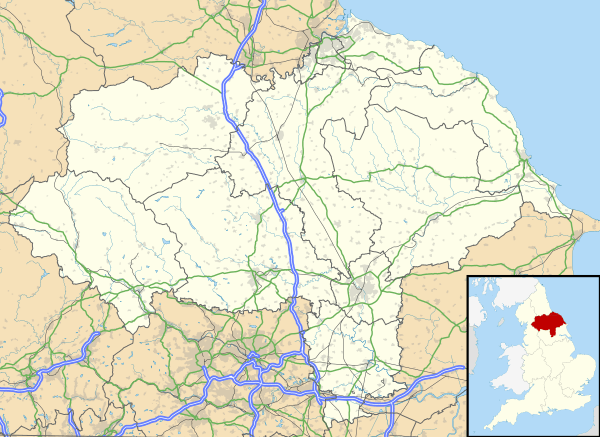 Skelton Location within North Yorkshire | |
| Population | 1,549 (2011 census) |
| OS grid reference | SE570561 |
| Civil parish |
|
| Unitary authority |
|
| Ceremonial county | |
| Region | |
| Country | England |
| Sovereign state | United Kingdom |
| Post town | YORK |
| Postcode district | YO30 |
| Police | North Yorkshire |
| Fire | North Yorkshire |
| Ambulance | Yorkshire |
| UK Parliament | |
The village name probably began as the Anglo-Saxon 'Shelfton' – 'the settlement on high ground'– becoming the present 'Skelton' under the invading Danes. The village, along with nearby Overton, is mentioned in the Domesday Book.[1]
According to the 2001 census the parish had a population of 1,640, reducing to 1,549 at the 2011 Census.[2] Between 1974 and 1996 it was in the Ryedale district and prior to 1974 in the historic North Riding of Yorkshire.
History
Skelton is mentioned in the Domesday Book, but its name indicates Anglo-Saxon and Danish influences.[1]
Skelton Grange was built by the Place family originally in the 18th century and rebuilt after fire in 1866. 'The Grange' was finally sold in 1981 due to a lack of funds for upkeep. It was demolished by a local property developer for a large housing development on the site.[3]
The York Corporation bought Fairfield House on the opposite side of the main Road in 1918 and opened it as a tuberculosis sanatorium in the following year. It is now a hotel. (A tuberculosis dispensary was also opened in Castlegate in the City of York, in 1913, but no longer exists.)[4]
Governance
Skelton is part of the Unitary Authority of the City of York Council. As of 2010 the Ward of Skelton, Rawcliffe and Clifton Without is represented by Councillors Richard Moore and Irene Waudby of the local Liberal Democrat Party and by Joe Watt of the local Conservative party.[5]
Skelton Parish Council is elected by the residents of the parish to administer local matters and consists of nine Councillors.[6]
Demography
In 1890 its population was recorded as 313. By 1901 the village was recorded as comprising 2473 acres with a population of 270 having varied over the previous hundred years between 203 and 367; most were employed in servicing the large houses and in agriculture. In 1951 the population was still only about 481 but then expanded rapidly.[1] In 2001 the population stood at 1,640.
Economy
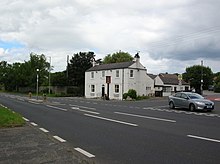
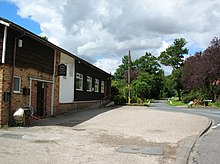
The village was primarily agricultural in nature, but is now mostly residential with a small commercial district to the south west of the village. Local Services consist of a Post Office and General Store, one Public House and one Social Club, and a Doctor's Surgery.[7]
Geography
The old village centre stands on a deposit of boulder clay, taking this part to a height some 25 metres above sea level, 10 metres more than the remainder of the village which is on strong clay, resting on gravel and sand. Within the settlement are several ponds, indicating a high water-table.
The flora and fauna was documented in two surveys, one in 1956 and then in 1971. In and around the village the surveys identified 100 species of bird, 328 species of trees and plants, 8 different ferns, 31 different types of moss, 9 fungi and amphibians including frogs, toads, the Warty or Crested Newt and the Smooth Newt. Also recorded were 21 species of mammals including the Whiskered Bat and the Long-Eared Bat. The bats and the Crested Newts in the village are protected species.
In the village open spaces have been cared for by the Parish Council and local volunteer groups and include The Green, Crooking Green, Orchard Field, The Pasture, Skelton Pond, the open spaces at Sycamore Close and Brecksfield.
The long, narrow plot boundaries extending back from the older houses are an example of the typical medieval pattern of 'toft and croft' agriculture.[8]
Transport
The main road which runs to the west of the village (from York towards Thirsk) was a turnpike and then in the last century became a major trunk route the A19.
There were attempts to turnpike the York-Northallerton road that passed through Skelton in 1749, but these failed. The scheme was revived in 1752 when the York Corporation sought that no gate should be nearer to York than the north end of Skelton, and that the section of the road nearer York should be repaired first. The Turnpike Trust was established in 1753. The trust was renewed in 1778, 1794, 1808, 1830, and by the Continuance Acts until 1874.[9]
The village is served by four bus services as part of the York to Easingwold route, two further services as part of the York to Thirsk route, and one local service to York (which enters the village itself, but terminates here; it runs to Rawcliffe and parts of Clifton and thence to the City Centre, and is a council-supported service due to low demand).[10]
Education
A school was built in 1872. It accommodated 120 children, and had an average attendance of about half that number. Now primary education is catered for at Skelton Community Primary School located in Brecksfield.[11] The village is within the Local Education Authority catchment area for Vale of York Academy on Rawcliffe Drive in nearby Clifton Without.[12]
Religion
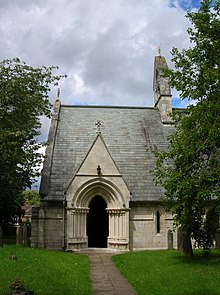
The Church of St Giles, formerly known as All Saints, dates from 1247, having been restored between 1810 and 1818 by Henry Graham and in 1863 by Ewan Christian. It is a Grade I listed building.[13] The register dates from the year 1538.[14]
Local tradition maintains that it was built, in 1227, with the stones that remained after the building of the south transept of York Minster. The church is thus sometimes called "Little St Peter's". There is probably some truth in this as the following extract from Archbishop Grey's roll shows that its building took place previous to the year 1247:
"Confirmation of a donation to the chapel of Skelton. To all, etc. The donation which our beloved son in Christ, Master E. Hagitur, treasurer of York, made to John de l'Edes, clerk of the chapel of Skelton, considering it to be agreeable and satisfactory to us, we confirm the same by our Pontifical authority, desiring the said treasurer, and his successors, to pay annually the sum of 20d. to this parson. In witness whereof, &c., &c. Dated at Thorp, on the 6th day of the Ides of December, A.D. 1247."
Despite two restoration schemes, the church has stood "virtually unaltered" since it was built, and is claimed to be "now one of only two complete Early English churches in the country." It is mentioned by Nikolaus Pevsner in his 1966 The Buildings of England: Yorkshire North Riding, by John Betjeman in his 1958 English Parish Churches and by Simon Jenkins in his 1999 England's Thousand Best Churches.[15]
The minister is Rev. Malcolm Wainwright.[16]
Sports
Skelton Football Club played in the York Sunday Morning League Division until 2010.[17]
Notable landmarks and residents
The Church of St. Giles is a Grade I listed building, dating from 1247,[18] Skelton Manor is Grade II* listed,[19] and Grade II listed buildings include Pyramid House.[20] The old Toll Bar Cottage was built when the road north was turnpiked. There is also a George VI post-box in the wall of the old post office, and a mounting block outside the Blacksmiths Arms.
The Blessed John Nelson, whose Feast day is 3 February, was a Jesuit martyr born in Skelton. He was ordained at Douai at the age of forty and sent to London in 1576 where he was arrested and martyred at Tyburn by being hanged, drawn, and quartered. John became a Jesuit just before his death.[21]
Notable residents include author Justin Hill, whose family home was here from 1985–2004.
References
- "Village History". Retrieved 4 November 2010.
- "Civil Parish 2011". Neighbourhood Statistics. Office for National Statistics. Retrieved 19 February 2016.
- "Skelton Grange". Retrieved 4 November 2010.
- "Fairfield Manor History". Retrieved 4 November 2010.
- "Councillors". Retrieved 4 November 2010.
- "Parish Councillors". Retrieved 4 November 2010.
- "Village Services". Retrieved 4 November 2010.
- "Village geography" (PDF). Retrieved 4 November 2010.
- "Turnpikes". Retrieved 4 November 2010.
- "Bus Services". Archived from the original on 7 December 2008. Retrieved 4 November 2010.
- "Schools". Retrieved 4 November 2010.
- "Guide to School Catchment Areas" (PDF). york.gov.uk. p. 63. Retrieved 6 December 2017.
- "Church of St Giles, Skelton". britishlistedbuildings.co.uk. Retrieved 11 May 2013.
- "Church History". Retrieved 4 November 2010.
- St Giles' Church, Skelton, York, booklet available from the church, p.1
- "St Giles Church, Skelton, York". stgileschurch.webeden.co.uk/. Retrieved 11 May 2013.
- "Football". Retrieved 4 November 2010.
- Historic England. "Church of St Giles (Grade I) (1315980)". National Heritage List for England. Retrieved 26 September 2015.
- Historic England. "Skelton Manor (Grade II*) (1149145)". National Heritage List for England. Retrieved 26 September 2015.
- Historic England. "Pyramid House (Grade II) (1296256)". National Heritage List for England. Retrieved 26 September 2015.
- "Catholic Martyr". Retrieved 4 November 2010.
- Place family papers, Cheltenham